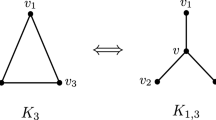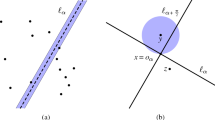Abstract.
By solid balls, we mean a set of balls in R 3 no two of which can penetrate each other. Every finite graph G can be represented by arranging solid balls in the following way: Put red balls in R 3, one for each vertex of G, and connect two red balls by a chain when they correspond to a pair of adjacent vertices of G, where a chain means a finite sequence of blue solid balls in which each consecutive balls are tangent. (We may omit the chain if the two red balls are already tangent.) The ball number b(G) of G is the minimum number of balls (red and blue) necessary to represent G. If we put the balls and chains on a table so that all balls sit on the table, then the minimum number of balls for G is denoted by b T (G). Among other things, we prove that b(K 6)=8,b(K 7)=13 and b T (K 5)=8,b T (K 6)=14. We also prove that c 1 n 3<b(K n )<c 2 n 3 log n, c 3 n 4 log n<b T (K n )<c 4 n 4.
Similar content being viewed by others
Author information
Authors and Affiliations
Additional information
Received: March 29, 1999 Final version received: January 17, 2000
Rights and permissions
About this article
Cite this article
Maehara, H., Oshiro, A. Arranging Solid Balls to Represent a Graph. Graphs Comb 18, 343–365 (2002). https://doi.org/10.1007/s003730200026
Issue Date:
DOI: https://doi.org/10.1007/s003730200026




